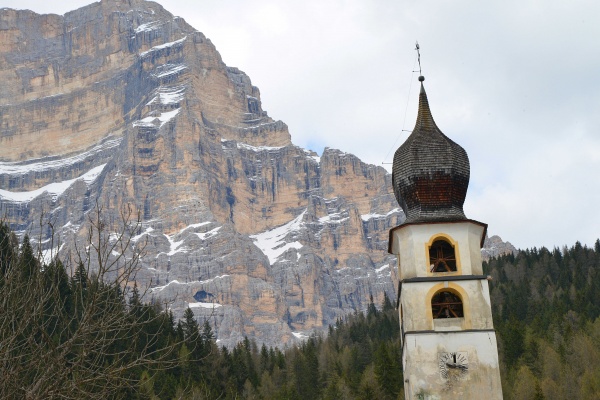CURRENTLY NOT ACCESSIBLE DUE TO LANDSLIDE IN THE FIRST SECTION FAIN - CASTELAZ
A pleasant walk, always along easy roads with no important vertical height gain, crosses the Prampèra torrent at Pian de le Tàie and arrives at Castelàz, which has long been a favourite place for the families from Forno to let their children enjoy playing in the sand and water.
In the centre of Forno di Zoldo (840m) cross the bridge over the Mae torrent and continue towards Baron, past the Prampera torrent to reach Barat (863m). Along this torrent the majority of the blast furnaces were situated and in the past centuries nails and tools were produced, (the last furnaces were destroyed in the 1966 flood). On an old noble house there is evident writing which indicates on the left via Baron and on the right via Pramper. Following this last indication climb up gently towards the Cesure woods of fir and larch trees, going by an old building, (wooden hut and house) in Fain and continue straight ahead, (to the left there is a small road which comes from Baron). Shortly ahead, level with Aiva picola where the road becomes steeper, on the right, outside the fence which surrounds the water container there is a fresh water spring. After a short flat section, cross Prampera over a nice little bridge and continue straight on, going along a stone wall, and pass by “casera dei Cini” (restored) and finally come out into Castelaz (997m, roughly 30 minutes), situated on the main road which goes from Forno to Val Pramper, (the trail continues uphill, till it reaches the farm house, inside the National Park of the Belluno Dolomites). The name is linked to the presence of an old castle which has given rise to the legend of “Dame di Castelaz” of which no trace remains, not even in documents.
Here, on summer days, it is easy to see groups of children playing in the water, while their parents are sunbathing. The view opens uphill (south) toward the Cime di Prampèr, while to the north the vegetation of the mass of Mount Pelmo emerges. For the return you can choose the equally easy road for Val Prampèr, which goes down around the biotope of Pra Torònt, with some possible alternatives: 1) keep going along it until the cross-country ski track on the right, following this you arrive at an evident curve on the left, where (red material hanging on a fir tree) you turn off into a path going down to Forno, into the hamlet of Borgo Rocchette, from where, by crossing the Maè, you return to your starting point (first of all flat but then the last part of the path is very steep); 2) follow it all the way then, at the second bend (Borgo Europa) turn into the road which goes down to the church of Saint Anthony of Forno, (going back up the same road you reach Pralongo). In all cases the return takes little more than half an hour.
The church of St. Anthony
The church of Forno, built during the first half of the 15th century and then expanded and restructured in 1619, was managed by the holy Confraternity of the Battuti (Flagellants) until 1806, when Napoleon decreed the dissolution of all religious congregations. On the outside facade of the church, under the rose window the Madonna of the Battuti is barely visible, and above the rose window the Virgin patroness of the Battuti is dressed in the traditional white robe.
Inside, on the minor altar dedicated to St. Anthony, is an altar piece with the saint in adoration of the Infant Jesus; in the background is the church of St. Floriano, the square of the parish church with the parish house and the house of the chaplain of the confraternity of the Battuti, while a column of Battuti, dressed in white and hooded, holding candles, make their way in procession towards the parish church.
[contents: Unione montana Longaronese Cadore Zoldo]
CURRENTLY NOT ACCESSIBLE DUE TO LANDSLIDE IN THE FIRST SECTION FAIN - CASTELAZ

















